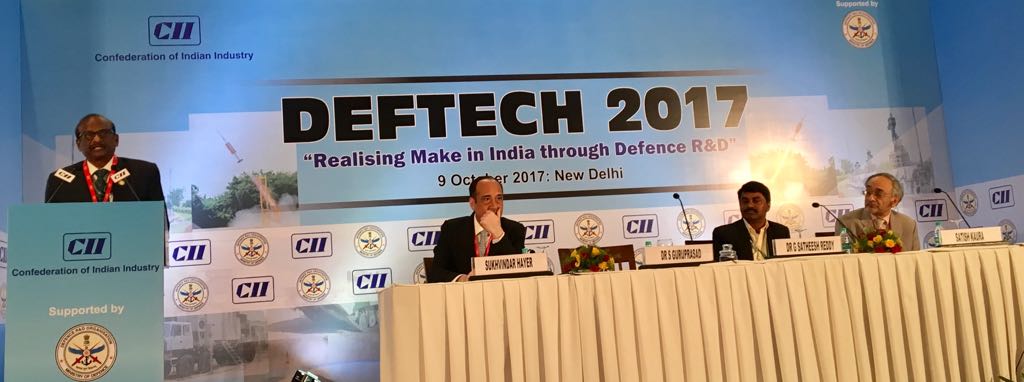Metallurgy skills are Kalyani Group’s springboard to defence production
 The Kalyani Group's Bharat 52 gun, which is undergoing test firing at present
By Ajai Shukla
The Kalyani Group's Bharat 52 gun, which is undergoing test firing at present
By Ajai Shukla
Business Standard, 23rd Oct 17
Indian engineers, who struggled for decades to design high-tech weaponry like the Tejas fighter and Arjun tank, are enjoying unusually quick success in developing what promises to be a world-class artillery gun.
At firing trials on September 4, prominent defence firm, Tata Power (Strategic Engineering Division), was cock-a-hoop when its Advanced Towed Artillery Gun System (ATAGS) fired three shells to a world-record 47.2 kilometres – three kilometres longer than contemporary guns.
But Tata Power (SED)’s record lasted just one day.
The next morning, a second ATAGS gun, which the Kalyani Group has built according to a parallel development strategy, broke that record by achieving a range of just over 48 kilometres.
Both guns achieved this record-breaking performance with “high explosive – base bleed” (HE-BB) ammunition, which is optimised for longer ranges.
The Defence Research & Development Organisation (DRDO), which conceived and designed the 155-millimetre, 52-calibre ATAGS, has fed the design to Tata Power (SED) and the Kalyani Group. Based on those requirements, the two companies have built and are test-firing competing gun prototypes.
While Tata Power (SED) has worked with the DRDO earlier, the new partnership with Kalyani Group is proving to be an inspired choice. The Pune-based firm has engineered a barrel and breech so good that the Tatas are using it in their gun as well.
While Kalyani Group is relatively new to modern defence systems that incorporate advanced information technology, its flagship company, Bharat Forge – the world’s largest forgings manufacturer – is a global leader in metallurgy expertise.
Metallurgy is fundamental to any defence industry, since it underpins the construction of guns, armoured platforms and warships. The 430-year-old German metals giant, Krupp, spearheaded the emergence of Germany’s defence industry, and leads it even today. The Kalyani Group believes it can do the same for India.
Says the Kalyani Group’s hard charging supremo, Babasaheb (Baba) Kalyani: “Our basic technology competence lies in metallurgy. We make our steel, we forge it, we machine it, we heat treat it. Very few companies in the world can match our skills in products like gun barrels.”
Over the years, Kalyani Group has integrated upstream as well as downstream from Bharat Forge. Pune-based Kalyani Carpenter and Kalyani Steels make alloy steel for the ATAGS barrel. Another group company, Mysore-based Automotive Axles, specialises in “drive lines”, on which the gun is mounted. A high-tech fabrication shop in Satara assembles the gun.
Business Standard visited the Kalyani Group facility in Pune, where the company is developing several artillery systems at its own cost, in order to develop skills. The guns are built in an artillery factory bought from Swiss defence firm, RUAG, and shipped in entirety from Austria to Pune.
Its produces include the 155-millimetre, 52 calibre Bharat 52, which is undergoing test firing; a 45 calibre version of the same gun; a truck-mounted 105-millimetre gun called the Garuda, which the army found so promising it financed it through the Army Technology Board; and a 155-millimetre, 39 calibre, titanium ultra-light howitzer that Kalyani is pitching against the BAE Systems M777 gun that India has contracted for.
“The Indian Army has already bought 145 M777 guns. But, by March [2018], my indigenous ultra-light howitzer will be ready to compete with the BAE Systems gun”, promises Kalyani.
Kalyani Group engineers who work on ATAGS say its exceptional range stems from its larger chamber – 25 litres, compared to 23 litres in similar guns. This allows the gun to be fired with more explosive, propelling the warhead further. To absorb the higher “shock of discharge”, Kalyani Group says it has built its barrel and breech with a complex new metallurgy.
Making ATAGS an easy-to-handle gun is an unprecedented all-electric system, in which machinery does what gun crews do manually in other guns: handling heavy ammunition, ramming it into the chamber and opening and closing the heavy breech.
Its one-of-a-kind, six-round “automated magazine” loads and fires a six-round burst in just 30 seconds. Most other guns in service have three-round magazines that must be reloaded after firing three rounds.
Firing off six rounds in 30 seconds is an important capability since artillery causes most casualties in the initial burst of fire, which catches enemy soldiers in the open. Once they dive into their trenches, artillery fire is less effective.
“The ATAGS team has created a new benchmark in artillery. For decades, no new artillery gun has been designed anywhere in the world. This is the first gun in 30 years designed afresh, from scratch”, points out Baba Kalyani.
The next test for the gun is “cold weather trials” in Sikkim in December. Before then, the gun will undergo some modifications. To expedite trials, Tata Power (SED) and Kalyani Group will start the building of three more ATAGs prototypes.
source :
http://ajaishukla.blogspot.in/



























